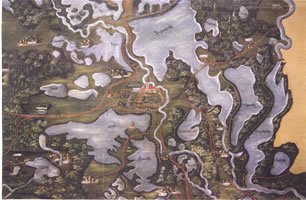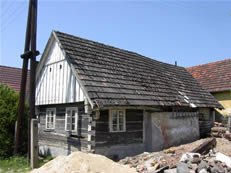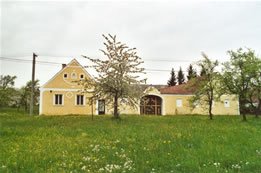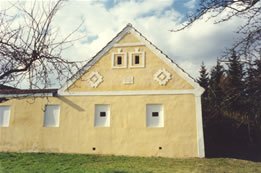The Old Bohemian Homeland
The craddle from where many Czechs left for America
.....He found himself in big troubles because his wife just died, having left a baby behind; this died in six weeks too and only the 14-years old daughter remained to him. He set his heart on America too and I promised to help him out with the travel, but he had to leave the daughter behind until she will be able to travel, which happened on the third year after our departure and then she really came to us....
Quotation from the memories of Frantisek Chadima, first published in 1884 in Czechoamerican calendar „Amerikan“,
reprinted in the book „Tam za mořem je Amerika“.
Most of rural South Bohemia was settled and developed relatively late. Until the 11th century, when most of Europe was already well developed, most of South Bohemia was still covered in dense inhospitable fir forests, known as the Hercinian forests. Although some human settlements already occurred along the rivers in this area, most of the lands remained outside the early developments. The final colonization of this area took place only after the 10-11th century AD.
From the 12th century till 1611, most of South Bohemia was under control of the Rozmberk family, an important Czech aristocratic dynasty. Their insight gave the landscape its present day appearance including the World Heritage Town Cesky Krumlov and the Ramsar-Convention protected fishponds around Trebon.



The Rozmberk brothers Vilem (left) and Petr Vok around 1600. The map shows Trebon, owned by the Rozmberks,
surrounded by
numerous little hamlets and artificial fishponds. At the height of their power
around 1600,
the Rozmberk domains covered about 1700 square kilometers (670 Square miles).
Since the 16th century until 1918, the Czech lands were part of the Hapsburg Empire. Certainly in the rural areas there were many restrictions and until 1848 most peasants were serfs of the noble families. They were registered in parishes and belonged to manors. In the earlier days, a regional noble family would own almost everything including most of the villages, small towns, and lands (mentioned as their "manor"). Farmers had gotten the right of use on the farm and land and could pass this on to their offspring or sell the right of use outside the family, but the real ownership mostly lay with the manor.
Farmers also had to pay lease and do several days or weeks of "robota" for the manor. Robota (from which the word robot came) was the obligatory labor done on the lands of the manor, specified as "with" or "without" livestock: bring your own ox to plough my land! Finally, they needed special permissions to move away to, or marry somebody from another parish or manor; it meant losing labor and income for the parish or manor!
Villages also had a strong hierarchy, ranking from the larger farm owners down to farmhands and poor people.


Left: one of the few large courtyard farms in Kojakovice. Most farms were medium size (pictures below).
A courtyard farm had two largely closed wings, a front wall with gate and an open, roofed-over rear wing.
Right: one of the last wooden cottages or laborer houses in the Trebon region.
It was quite common that marriage agreements were arranged to make sure that the farm stayed in good family hands and progressed. A good way to do this was arranging "that one of your children marries a child of me, your other child marries a next one of me; one couple gets your farm and the other couple gets my farm".


A restored courtyard farm of medium size. Historically, only the front part of one wing (left wing in the picture at left) was
used as living quarters, the rear part of the that wing and the other wings were used as stables and storage.
The right wing looks normal, but the lack of windows shows that this wing was used as storage for grains and other products.
Passing on a farm was also no casual business. Marriage contracts or last wills described in detail the value of the farm, fields, livestock, and farm utensils. Outstanding debts were mentioned and siblings had to be paid their fair share. Not many farmers had cash available, so debts to siblings and older generations and their repayment were often included in the Land Record Registers (Cadastre Register).
Unless mentioned differently, all pictures are © collection Rozmberk Society, Friends of the Rozmberk Society, or provided under © by individual partners. In some instances, copyright is public domain or could not be established or obtained within reasonable effort.
Design by the Bear (Robert Dulfer 2006-2016)


